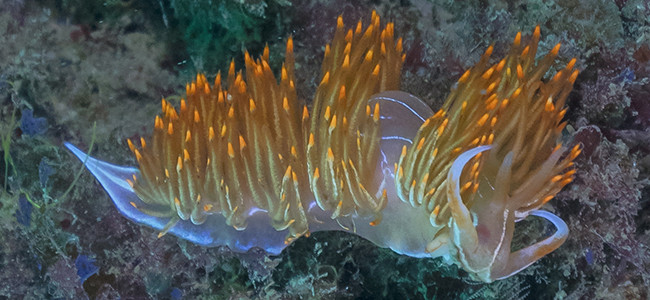Luisella babai is a nudibranch belonging to the family Facelinidae. This marine mollusc is named after the Italian malacologist N. Baba, an expert in opisthobranchs, honoring his contributions to the study of these animals. Luisella babai is mainly distributed in the Mediterranean Sea and the northeastern Atlantic, found in shallow coastal areas, especially in regions rich in algae, rocks, and underwater meadows. This nudibranch is appreciated by divers and marine biologists for its beauty and interesting behavior.
Luisella babai has an elongated body that can reach 3 to 5 cm in length. Its coloration is very distinctive, with a translucent body ranging from shades of blue to light gray, often with a pinkish or yellowish tint. The most distinctive morphological feature is the cerata—elongated, finger-like structures arranged in parallel rows along its body. The cerata are translucent, revealing the animal’s digestive system inside, which is usually reddish or brownish in color. The tips of the cerata are often white, blue, or bright yellow, providing a striking contrast with the rest of the body. The rhinophores, sensory organs located at the front of the body, are smooth, dark-colored, and lack rings or ornamentation as seen in other species. Compared to other nudibranchs like Facelina auriculata, Luisella babai is distinguished by its more orderly arrangement of cerata and its softer, more delicate coloration.
Regarding its diet, Luisella babai is carnivorous and mainly feeds on hydrozoans, small colonial organisms living on rocks and algae. The nudibranch uses its radula, a tongue-like structure with tiny teeth, to scrape and consume the hydrozoans. This feeding behavior is typical of facelinids, which specialize in prey with stinging defenses. Additionally, Luisella babai can utilize the stinging cells of its prey, called cnidocytes, and store them in its cerata, providing extra defense against predators.
Reproduction in Luisella babai is hermaphroditic, as in most nudibranchs, meaning each individual possesses both male and female reproductive organs. During mating, two individuals exchange sperm, and both then deposit their eggs in gelatinous spirals on hard surfaces such as rocks or algae. The hatched larvae are planktonic, floating in the water column until they settle on the seabed and undergo metamorphosis into juveniles.
A fascinating aspect of Luisella babai is its ability to ‘steal’ its prey’s defenses. By feeding on hydrozoans, the nudibranch not only digests them but also incorporates their cnidocytes (stinging cells) into its own cerata, enabling it to defend itself against potential predators. This strategy, known as kleptocnidism, is a clear example of symbiosis in nature, as Luisella babai benefits both nutritionally and defensively from its interaction with hydrozoans.
Photos:

